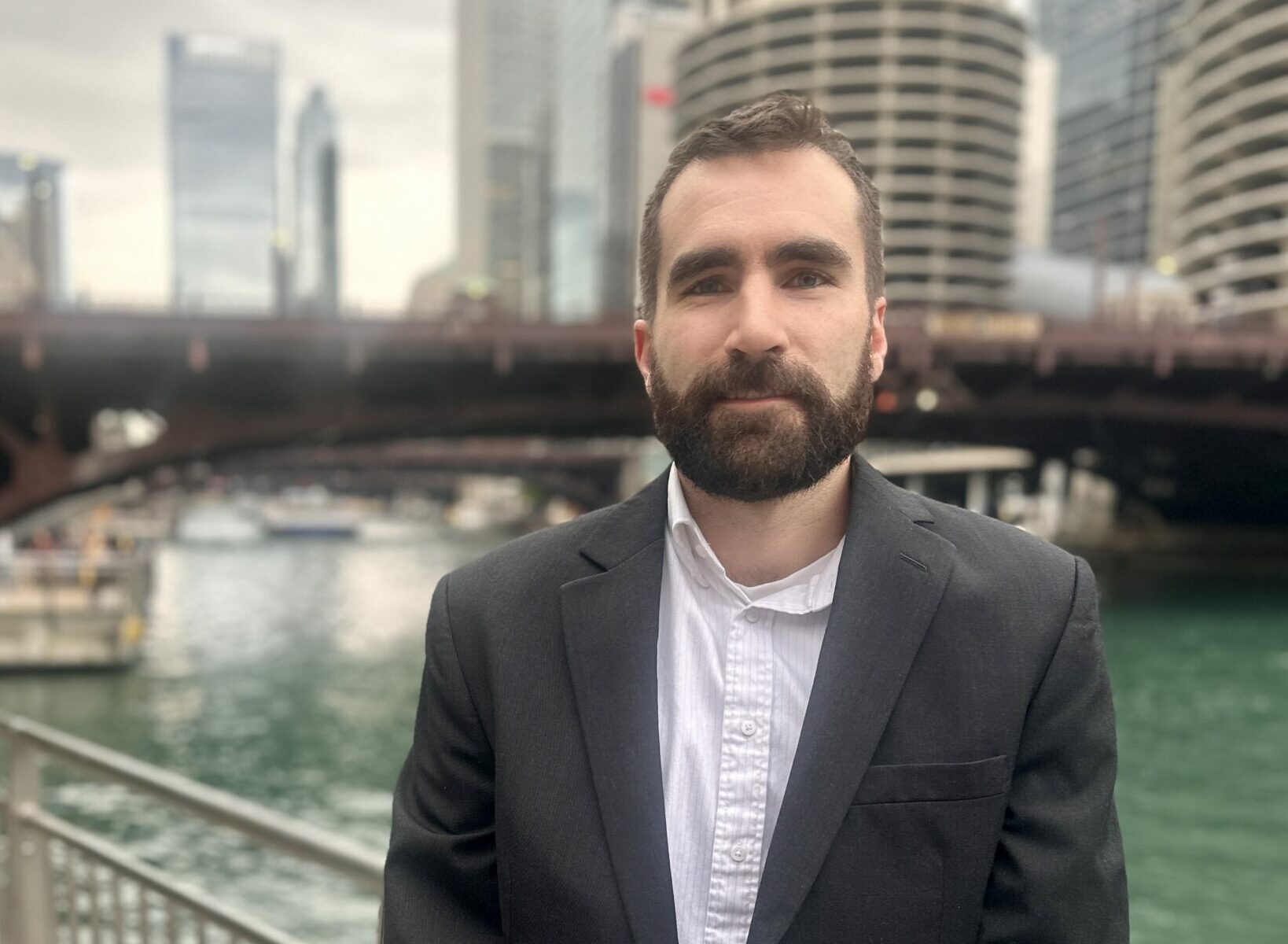Photo by Oran Viriyincy
April 29, 2024
Let’s GET(s) Smart About Transmission
Building a smarter, more efficient grid for the future starts with three steps.
Update
On May 13th, the Federal Electric Reliability Commission (FERC) issued new, landmark rules on transmission planning and cost allocation. The rules will help to modernize and expand the electrical grid to meet our increasing energy demands with clean energy, while ensuring that costs for new transmission capacity are fairly distributed among states benefiting from these new improvements. The Commission’s second rule revises existing regulations to create an avenue to federal permitting of transmission lines, a role that has historically resided with state authority.
To fully decarbonize our economy and electricity system, we’re going to need a lot more clean electricity. While “how can we generate more clean electricity?” is a pertinent question, the larger challenge has become “how can we deliver clean electricity where we need it and when we need it?”
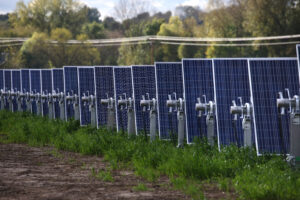
For example, in the Midwest, Great Plains states like Iowa, Nebraska, and the Dakotas generate the lion’s share of our nation’s wind power. But we don’t need an excess of clean electricity in the Great Plains. We need transmission lines to deliver it to the Midwest’s urban centers like Chicago, St. Louis, and Minneapolis where it’s more heavily consumed.
A widespread, smart, and efficient delivery of clean electricity ensures we conserve energy, meet demand to maintain reliability, and unlock the full potential of our growing fleet of clean energy resources. This is where we are confronting a growing hurdle to clean energy goals: our country’s outdated, congested, and underutilized grid. But there are solutions.
Here are three vital steps we can take to build a smarter, cleaner, and more efficient grid for the future:
First, we need more transmission and distributed energy resources (DERs) to decarbonize. Second, we also need an improved approach to building transmission while ensuring clean energy development, conservation, and environmental justice aren’t at odds. Lastly, let’s not overlook the added benefits of advanced transmission technologies, including grid-enhancing technologies (GETs), which can give our aging grid some much-needed love.
1 ) We need more transmission and distributed energy resources (DERs) to decarbonize the economy.
To fully decarbonize our electricity system, we’ll need a lot of new, local, community-based renewables and a lot of new utility-scale wind and solar farms.
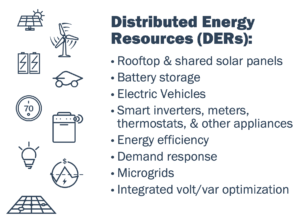 By adopting a “both/and” approach to decarbonization rather than an “either/or,” we can co-optimize bulk-scale and local resources. This approach of scaling utility renewables and local solar and storage maximizes cost-efficiency by employing economies of scale, reducing transmission and distribution costs, and avoiding energy costs by reducing peak demand.
By adopting a “both/and” approach to decarbonization rather than an “either/or,” we can co-optimize bulk-scale and local resources. This approach of scaling utility renewables and local solar and storage maximizes cost-efficiency by employing economies of scale, reducing transmission and distribution costs, and avoiding energy costs by reducing peak demand.
Unlike DERs however, which generate electricity close to where it is consumed, large wind and solar farms are typically sited in remote areas and need to be “hooked up” to the electricity grid. As a result, we need to create more space in the transmission system to carry clean energy to the places it’s needed most.
This requires complementary approaches: (1) constructing new, smart, and cost-effective transmission lines that carry renewable energy to population centers, and; (2) getting better performance from the transmission system we already have, by using advanced transmission technologies such as energy storage, dynamic line rating, distributed energy solutions, and reconductoring.
2 ) “Smart from the start” transmission is necessary to ensure renewable energy development, conservation, and environmental justice aren’t at odds.
To utilize utility-scale clean energy generation, we need more transmission lines. Where we decide to build these new transmission lines is what we call the process of siting.
Currently, transmission developers have a responsibility to publicize their projects in the communities they cross and to negotiate with landowners for necessary property rights. But in many states, developers are not required to consult with communities regarding the design and route of new lines. The result has been that, by the time a community identifies real problems with a developer’s proposal, the developer has already finalized its plans.
Moreover, regional planners have historically calculated the cost of siting on the assumption that each proposed transmission line will chart a “straight-line” path between substations. It does add a 30% cost adder to account for “routing constraints,” but the adder is the same for all projects, regardless of actual conditions on the ground.
This approach isn’t so practical anymore with urban development, conservation areas, and private land ownership gobbling up so much American real estate. So, it’s not so easy for transmission planners to build a “straight line” today as it was decades ago.
The existing rules fail to filter out projects with bad siting plans whose “straight lines” cause avoidable harm to habitats, urban development, environmental justice communities, and even military operations in some cases. Operating under the assumption that new transmission can be built as the crow flies has, unsurprisingly, led to a growing number of siting disputes, delays, and costly litigations that are clogging up the queues to the many clean energy projects hoping to connect to the grid across the country.
Luckily, there’s a fairly simple solution – FERC should require regional planners to consider siting at the front end and develop rules of thumb to weed out projects that are likely to lead to unnecessary siting disputes down the line. Specifically, FERC should require transmission planners to develop transparent siting-related criteria for transmission project selection. This can help guide transmission planners in the project selection process, before the wheels of construction start.
We lovingly call this “smart from the start” transmission planning. With a FERC rewrite of our grid policy looming, the time is ripe to adopt this approach.
3 ) Thorough consideration of cost-effective advanced transmission technologies should be a no-brainer.
Siting planning dovetails with FERC’s renewed focus on advanced transmission technologies, such as “grid-enhancing technologies” (GETs), energy storage (including longer-duration storage technologies), and advanced conductors. In fact, a principal benefit of these technologies is that they avoid siting impacts altogether.
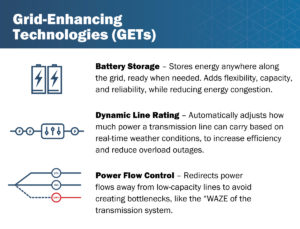 GETs, which provide increases in transmission capacity on existing transmission lines, offer the double benefit of being faster to deploy than new lines and less expensive. Think of it like upgrading your computer’s operating system. Instead of buying a new computer every time you need better performance, it makes far more sense to upgrade your operating system. Just like how a software update can optimize your computer’s resources and make it run more efficiently, GETs can optimize existing transmission wires, allowing them to carry more electricity without the need to build new transmission lines (in the case of one GET, topology optimization, it quite literally is an upgrade to the software utilities use to manage the grid).
GETs, which provide increases in transmission capacity on existing transmission lines, offer the double benefit of being faster to deploy than new lines and less expensive. Think of it like upgrading your computer’s operating system. Instead of buying a new computer every time you need better performance, it makes far more sense to upgrade your operating system. Just like how a software update can optimize your computer’s resources and make it run more efficiently, GETs can optimize existing transmission wires, allowing them to carry more electricity without the need to build new transmission lines (in the case of one GET, topology optimization, it quite literally is an upgrade to the software utilities use to manage the grid).
While we will still need more transmission, GETs allow us to meet our goals faster and at a lower cost. It’s unlocking potential in something we already have, rather than needing to buy something new.
And GETs are just one category of advanced transmission technologies that can help us improve our existing grid. Other examples include advanced conductors—materials like carbon fiber than allow transmission lines to carry more electricity than traditional materials like aluminum—and lithium-ion batteries, which can be strategically deployed at electric substations to reduce stress on the grid.
To reiterate, this is not an “either/or” choice between traditional large wires projects and new advanced transmission technologies. GETs and other advanced technologies are about embracing smart solutions in conjunction with transmission lines to unclog and enhance existing transmission capacity.
Sounds like a no-brainer, right? But there’s work to be done for our transmission system to reach its full potential. Mainly, working to ensure that GETs and other advanced transmission technologies are fully considered in transmission planning and development to maximize the cost-effective delivery of clean electricity while maintaining reliability.
Conclusion
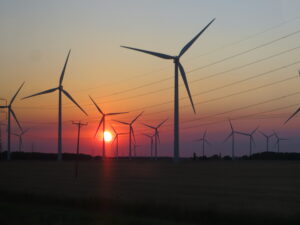 In summary, as we look to the future of our energy grid, it’s clear that a smarter, more efficient approach is needed. By embracing steps #1, #2, and #3 — increasing transmission and distributed energy resources, “smart from the start” siting planning, and fully utilizing advanced transmission technologies — the U.S. can overcome the challenges that have hindered progress. Delays, legal challenges, and other disputes challenging transmission lines represent a failure of planning and policy to ensure that steps #1, #2, and #3 occur.
In summary, as we look to the future of our energy grid, it’s clear that a smarter, more efficient approach is needed. By embracing steps #1, #2, and #3 — increasing transmission and distributed energy resources, “smart from the start” siting planning, and fully utilizing advanced transmission technologies — the U.S. can overcome the challenges that have hindered progress. Delays, legal challenges, and other disputes challenging transmission lines represent a failure of planning and policy to ensure that steps #1, #2, and #3 occur.
This systems approach not only reduces pollution but also limits costs, promotes transparency and inclusivity, and fosters competition in the energy sector. It’s time to get smart about transmission and build a grid, and grid policy playbook, that can support a cleaner, more sustainable future for all.


